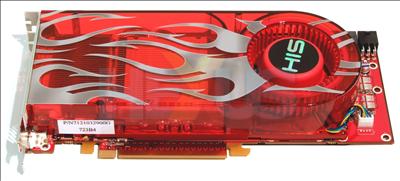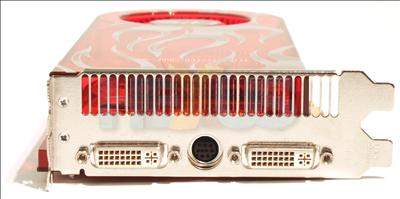Radeon HD 2900 Pro? A physical look
The HIS Radeon HD 2900 Pro is based the reference design which, in turn, is exactly the same as the Radeon HD 2900 XT 512MiB - in appearance, at least. That means the cooler and PCB are both identical to its bigger brother.Conjecturing somewhat, AMD has recently attempted to harvest full value from silicon that doesn’t quite make the grade – the tri-core Phenom being a prime example. The same is true for the Radeon HD 2900 Pro, which is, for all intents and purposes, a slower-clocked XT, so the same 320 stream processors and 512-bit memory bus feeding 512MiB of onboard frame buffer.
Radeon HD 2900 Pro ships with core/shader speeds of 600MHz, down from the 743MHz on the XT variant. Memory speed sees a minor drop, down from 1656MHz from the 512MiB-equipped XT to 1584MHz on this Pro.
What we can discern from looking at the clock speeds is that the Pro will be slower, obviously, but should produce between 80-85 per cent of the XT’s performance in GPU-limited scenarios.
AMD and its partners have needed to introduce another SKU in between the Radeon HD 2600 XT and HD 2900 XT, and the 2900 Pro makes for an intriguing choice – on paper – for around £175, which, not uncoincidentally, is the price for a stock-clocked GeForce 8800 GTS 320.
A physical look at the HIS Radeon HD 2900 Pro confirms our suspicions.
So everything we’ve written about the Radeon HD 2900 XT’s appearance is equally applicable here. It’s a double-height card whose fan exhibits an annoying pitch modulation when under 3D load.
The lower power requirement of this card dictates that you only need to use the six-pin PCIe connector for auxillary power.
Both DVI ports are dual-link and can carry HDCP-protected video through to a compatible monitor/TV. The R600 family uses brute GPU horsepower to alleviate high-definition decoding load from the CPU, rather than a dedicated ASIC (UVD) on the RV610/630.
In summary, then, there’s nothing really new to report here. The Radeon HD 2900 Pro is simply a slower-clocked XT, available for a lower street price, and designed to compete with NVIDIA’s GeForce 8800 GTS 320.














